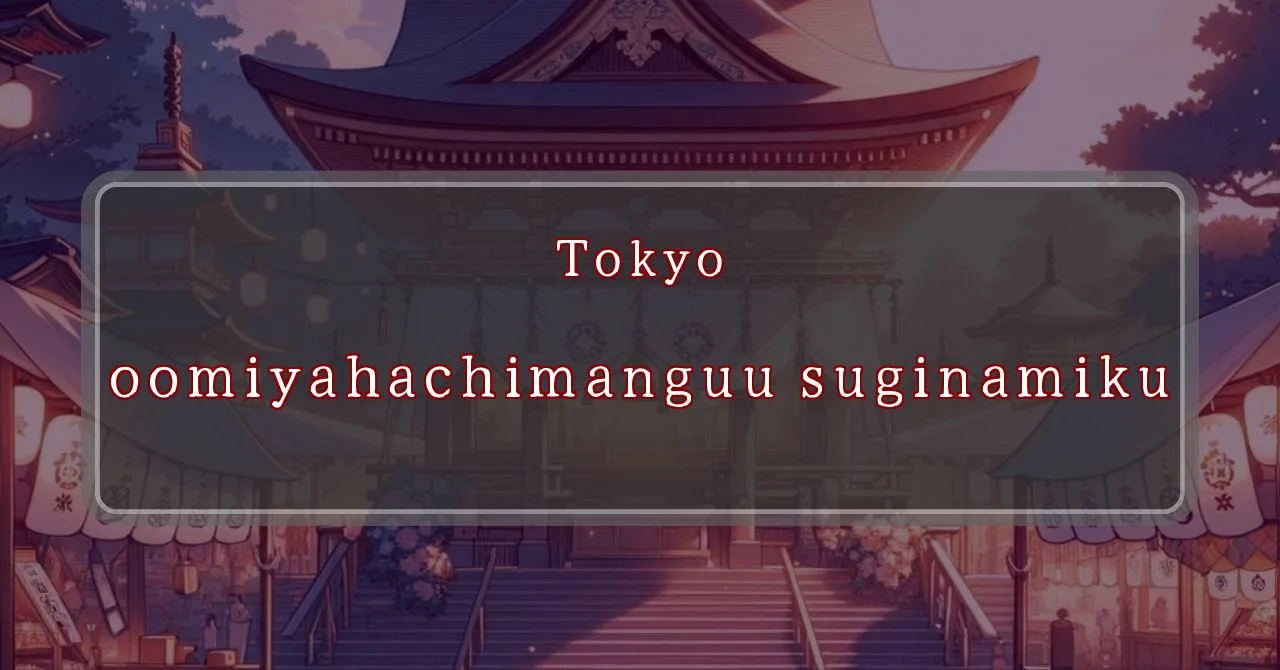Enchanting lights adorn the night at Omiya Hachimangu Shrine
Basic Information
Omiya Hachimangu Shrine is a Shinto shrine located in Suginami Ward, Tokyo, Japan. It is dedicated to the god Hachiman, the god of war and archery.
- Address: 2-3-1 Omiya, Suginami-ku, Tokyo 168-0061
- Phone Number: 03-3311-0105
- Access: 7-minute walk from Nishi-Eifuku Station on the Keio Inokashira Line
- Festival Days: September 13th (Fri) to September 16th (Mon), 2024
Main Events and Attractions of the Festival
The Omiya Hachimangu Shrine Festival is a lively and colorful event that attracts many visitors each year. The festival features a variety of events and attractions, including:
Mikoshi Procession
One of the highlights of the festival is the mikoshi procession. A mikoshi is a portable shrine that is carried through the streets by a team of people. The mikoshi of Omiya Hachimangu Shrine is particularly large and impressive, and it is carried by a team of over 100 people.
Kagura Dance
Kagura is a traditional Japanese dance that is often performed at Shinto festivals. The kagura dance at Omiya Hachimangu Shrine is performed by a group of young women who wear colorful costumes and masks. The dance is said to bring good luck and prosperity to the community.
Food Stalls
The festival also features a variety of food stalls that sell a variety of delicious Japanese dishes. Some of the most popular dishes include yakitori (grilled chicken skewers), takoyaki (octopus balls), and taiyaki (fish-shaped cakes filled with sweet red bean paste).
Games and Activities
In addition to the mikoshi procession, kagura dance, and food stalls, the festival also features a variety of games and activities for children and adults alike. Some of the most popular games include ring toss, beanbag toss, and goldfish scooping.
Fireworks Display
The festival concludes with a spectacular fireworks display. The fireworks are launched from a nearby park, and they can be seen from all over the area. The fireworks display is a beautiful and fitting end to the Omiya Hachimangu Shrine Festival.
Blessings and Deities
Omiya Hachimangu Shrine is dedicated to the god Hachiman, the god of war and archery. Hachiman is also revered as the protector of the imperial family and the nation of Japan. The shrine is said to have been founded in 1063 by Minamoto no Yoriyoshi, a powerful samurai warrior. Yoriyoshi is said to have prayed to Hachiman for victory in battle, and after he was victorious, he built the shrine to express his gratitude.
- Deity: Hachiman, the god of war and archery
- Blessings: Victory in battle, protection of the imperial family and the nation of Japan
Origin and History
The origins of Omiya Hachimangu Shrine can be traced back to the 11th century. In 1063, Minamoto no Yoriyoshi, a powerful samurai warrior, is said to have prayed to Hachiman for victory in battle. After he was victorious, he built the shrine to express his gratitude. The shrine was originally located in a different part of Suginami Ward, but it was moved to its current location in 1688.
- Founded: 1063
- Founder: Minamoto no Yoriyoshi
- Original Location: A different part of Suginami Ward
- Current Location: 2-3-1 Omiya, Suginami-ku, Tokyo 168-0061
Tips and Notes for Visitors
Here are some tips and notes for visitors to Omiya Hachimangu Shrine:
- Hours: The shrine is open from 9:00 AM to 5:00 PM every day.
- Admission: Admission to the shrine is free.
- Dress Code: There is no specific dress code for visiting the shrine, but it is considered respectful to dress modestly.
- Photography: Photography is permitted within the shrine grounds, but it is prohibited inside the main shrine building.
- Smoking: Smoking is not permitted within the shrine grounds.
Parking Information
There is a parking lot available for visitors to Omiya Hachimangu Shrine. The parking lot is located a short walk from the shrine.
- Location: The parking lot is located at 2-1-1 Omiya, Suginami-ku, Tokyo 168-0061.
- Hours: The parking lot is open from 9:00 AM to 5:00 PM every day.
- Fees: Parking is free of charge.
Popular Stalls and Food Carts in Recent Years
| Type of Stall | Description |
|---|---|
| Takoyaki | A staple at Japanese festivals. Characterized by a crispy outside and a creamy inside. |
| Jaga Butter | A simple yet popular snack of hot potatoes lavishly topped with melted butter. |
| Baby Castella | Small castella cakes, sweet and fluffy treats enjoyed by children and adults alike. |
| Grilled Ayu with Salt | Fresh ayu fish grilled whole with salt, a savory taste of Japanese summer. |
| Shaapin | A unique gourmet item influenced by foreign cuisine, with a chewy skin wrapping the filling. |
| Okonomiyaki | A Japanese grilled dish where you often choose your own ingredients for a personalized flavor. |
| Cotton Candy | A fluffy, sweet snack that’s extremely popular with children. |
| Chocolate Banana | A banana coated in chocolate, a fun and visually appealing dessert. |
| Kushiyaki | Various types of ingredients skewered and grilled, an easy-to-enjoy snack. |
| Yakisoba | Fried noodles mixed with a special sauce, a fast food favorite in Japan. |



